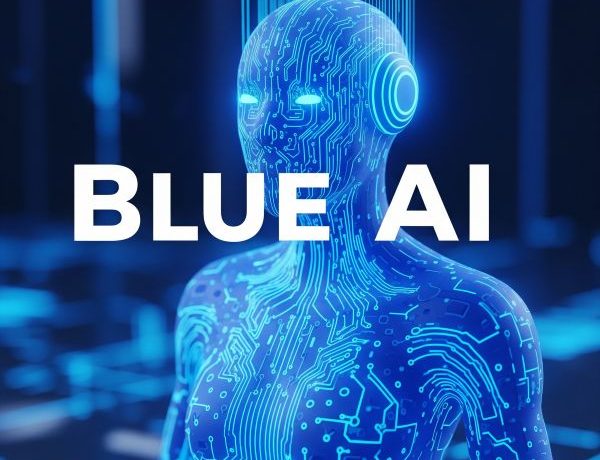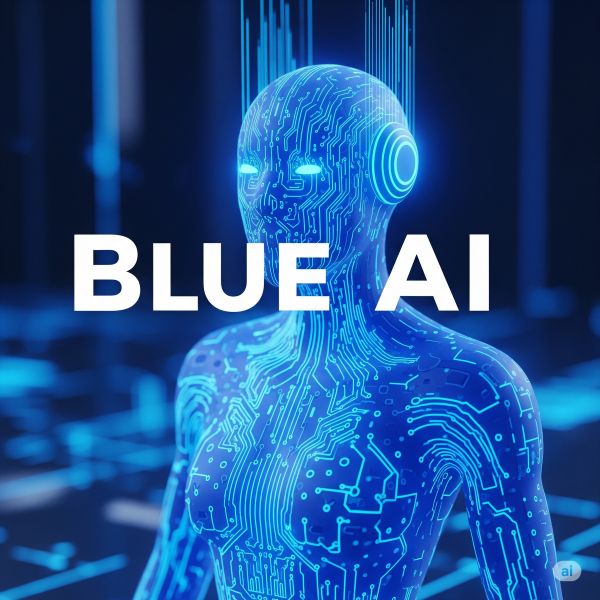
Blue Artificial Intelligence: The Future of Human-Machine Harmony
What is Blue Artificial Intelligence?
Blue Artificial Intelligence (Blue AI) is a cutting-edge evolution of artificial intelligence that emphasizes ethical integration, human-centric applications, and sustainable development. Unlike conventional AI that prioritizes performance and efficiency, Blue AI focuses on transparency, trust, and collaboration between humans and machines.
Table Of Content
- What is Blue Artificial Intelligence?
- Core Principles of Blue AI
- 1. Ethical Foundations
- 2. Human-Centric Design
- 3. Transparency and Explainability
- Applications of Blue Artificial Intelligence
- Healthcare Innovation
- Smart Cities & Urban Sustainability
- Finance and Responsible Automation
- Education and Skill Enhancement
- Blue AI vs Traditional AI
- Technological Backbone of Blue AI
- 1. Federated Learning
- 2. Explainable AI (XAI)
- 3. Hybrid AI Architectures
- 4. Quantum-Safe Algorithms
- Why Blue AI Matters in 2025 and Beyond
- Real-World Implementations of Blue AI
- IBM’s Watson Health
- Google’s AI Principles
- European Commission’s AI Act
- Challenges in Scaling Blue AI
- Future of Blue AI: Global Collaboration and Responsible Innovation
- Integrating Blue AI into Business Strategy
- A New Era of Responsible AI Adoption
- Steps for Enterprises to Adopt Blue AI
- Environmental Sustainability in Blue AI
- AI for Social Good: Blue AI Case Studies
- 1. AI in Climate Risk Prediction
- 2. Blue AI in Mental Health Support
- 3. Combating Misinformation
- Education and Workforce Transformation with Blue AI
- Key Initiatives Include
- Regulatory Frameworks Promoting Blue AI
- 1. The EU Artificial Intelligence Act
- 2. OECD AI Principles
- The Role of Open-Source Communities
- Conclusion: Blue AI as a Global Movement
The term “Blue” symbolizes stability, trust, and depth, reflecting the core goals of this emerging AI paradigm. It envisions an AI ecosystem where human values, privacy, and long-term benefits are embedded into every algorithm and neural network.
Core Principles of Blue AI
1. Ethical Foundations
Blue AI operates on a foundation of ethical governance. It ensures that decision-making systems are auditable, non-biased, and fair. From healthcare diagnostics to financial modeling, every model is developed with ethical AI frameworks such as Explainable AI (XAI) and Federated Learning to enhance trustworthiness.
2. Human-Centric Design
This approach shifts the paradigm from automation to augmentation, where AI complements human intelligence rather than replaces it. Blue AI prioritizes:
-
Usability and accessibility
-
Interdisciplinary collaboration
-
Empathy-based UX interfaces
This ensures that AI solutions respect cultural contexts and support human well-being.
3. Transparency and Explainability
Unlike black-box models, Blue AI promotes model interpretability. Whether in medical AI or government systems, Blue AI allows users to understand why a decision was made, making systems more trustworthy and accountable.
Applications of Blue Artificial Intelligence

Healthcare Innovation
Blue AI is transforming healthcare by:
-
Offering personalized medicine through genetic profiling
-
Enhancing clinical decision support systems
-
Enabling predictive diagnostics that improve patient outcomes
Systems designed with Blue AI uphold data privacy laws like HIPAA and GDPR while using encrypted federated models for cross-institutional learning.
Smart Cities & Urban Sustainability
From smart traffic management to climate-responsive urban planning, Blue AI powers intelligent infrastructures. Cities are now adopting ethical surveillance systems, energy-efficient building designs, and AI-driven disaster response systems, all built on transparent and accountable platforms.
Finance and Responsible Automation
Financial institutions are leveraging Blue AI to:
-
Detect fraud using ethically trained anomaly detection models
-
Provide inclusive credit scoring with minimal demographic bias
-
Automate customer support while preserving consumer rights
Education and Skill Enhancement
Blue AI is pioneering adaptive learning platforms that adjust to individual student needs. With neuro-symbolic reasoning models, it ensures that students receive fair assessments and equitable access to resources, irrespective of geographical location or economic status.
Blue AI vs Traditional AI
| Feature | Traditional AI | Blue AI |
|---|---|---|
| Focus | Efficiency & Profit | Ethics & Humanity |
| Transparency | Low | High |
| User Involvement | Minimal | High |
| Accountability | Weak | Strong |
| Bias Control | Reactive | Proactive |
| Sustainability | Optional | Core Principle |
Technological Backbone of Blue AI
1. Federated Learning
A decentralized model training approach that maintains data privacy by processing data locally and aggregating global insights. It ensures that sensitive personal data never leaves the user’s device.
2. Explainable AI (XAI)
With XAI, users and developers can understand model logic. This is essential in regulated sectors like healthcare and finance, where black-box predictions are legally and ethically unacceptable.
3. Hybrid AI Architectures
Blue AI often combines symbolic reasoning with neural networks to reflect human-like thinking. This allows systems to understand contextual nuances and make ethically sound decisions.
4. Quantum-Safe Algorithms
As AI and quantum computing converge, Blue AI incorporates quantum-resistant cryptographic methods to safeguard user data and ensure long-term security.
Why Blue AI Matters in 2025 and Beyond
In an age where AI is deeply embedded in governance, education, economy, and healthcare, we face risks related to bias, control, and ethical misuse. Blue AI stands as a bulwark against these threats by insisting on:
-
AI for good
-
Human dignity
-
Inclusive growth
As societies demand greater transparency and fairness, governments and tech giants are investing in Blue AI frameworks to regain public trust.
Real-World Implementations of Blue AI
IBM’s Watson Health
IBM’s evolution of Watson now prioritizes ethically sourced datasets and explainable medical predictions, aligning with Blue AI ethics.
Google’s AI Principles
Google’s shift towards responsible AI practices includes fair datasets, human oversight, and rigorous testing for harm, mirroring Blue AI standards.
European Commission’s AI Act
The EU is legislating risk-based AI regulation, reinforcing the Blue AI narrative with laws requiring transparency, traceability, and human oversight.
Challenges in Scaling Blue AI
Despite its benefits, Blue AI faces roadblocks like:
-
Data interoperability across platforms
-
High computational costs for privacy-preserving methods
-
Limited global standards for ethical compliance
Yet, with increasing global awareness and investment, these challenges are surmountable.
Future of Blue AI: Global Collaboration and Responsible Innovation
The evolution of Blue AI will be shaped by multistakeholder participation involving:
-
Policymakers
-
Tech communities
-
Civil society
-
Academic researchers
Only through collaborative innovation can we build AI that enhances human life without compromising rights or freedoms.
Integrating Blue AI into Business Strategy
A New Era of Responsible AI Adoption
Businesses today face increasing scrutiny regarding the social and ethical implications of AI. Integrating Blue AI into business operations isn’t just a moral choice—it’s a competitive advantage. By aligning with Blue AI values, companies can enhance brand trust, meet regulatory compliance, and future-proof their digital transformation.
Steps for Enterprises to Adopt Blue AI
-
Conduct an AI Ethics Audit
Evaluate existing AI systems for bias, privacy risks, and transparency gaps. -
Establish an AI Governance Committee
Build an interdisciplinary team to oversee all AI initiatives, ensuring they align with ethical frameworks. -
Invest in Explainable Models
Move away from opaque neural nets and adopt interpretable algorithms to build user confidence and support regulatory review. -
Enable Continuous Human Oversight
Maintain a human-in-the-loop approach in critical AI applications such as finance, law enforcement, and healthcare. -
Prioritize Diversity in AI Development
Ensure diverse voices are involved in dataset creation, model testing, and deployment, reducing the risk of systemic bias.
Environmental Sustainability in Blue AI
Blue AI supports the global climate agenda by reducing the carbon footprint of machine learning models. By adopting energy-efficient algorithms, leveraging green data centers, and optimizing model architectures, Blue AI helps mitigate the environmental cost of AI progress.
Tech companies are increasingly adopting AI model carbon accounting tools, such as the ML CO2 Impact Calculator, to quantify and reduce emissions during training and inference.
AI for Social Good: Blue AI Case Studies
1. AI in Climate Risk Prediction
Blue AI tools are being deployed to analyze weather patterns, forest fire probabilities, and coastal erosion rates using geospatial data—helping governments and NGOs respond proactively to environmental crises.
2. Blue AI in Mental Health Support
Platforms like Wysa and Woebot, built with empathy-first AI, offer mental health guidance while adhering to strict privacy policies. These chatbots use natural language processing not just to respond, but to understand emotional context.
3. Combating Misinformation
Using natural language understanding (NLU) and real-time fact-checking algorithms, Blue AI helps detect and curb the spread of fake news, ensuring the integrity of information online.
Education and Workforce Transformation with Blue AI
Blue AI doesn’t just automate tasks—it enables lifelong learning and reskilling. As AI continues to reshape the job market, it’s imperative that the workforce adapts accordingly.
Key Initiatives Include:
-
AI-augmented classrooms using adaptive learning algorithms.
-
Vocational training through simulated environments powered by Blue AI-driven AR/VR tools.
-
Continuous feedback loops in employee evaluation systems, ensuring transparent and constructive career development.
Regulatory Frameworks Promoting Blue AI
1. The EU Artificial Intelligence Act
One of the most comprehensive regulations globally, the AI Act classifies AI systems into risk categories and mandates explainability, fairness, and transparency in high-risk applications.
2. OECD AI Principles
These internationally recognized principles focus on:
-
Inclusive growth
-
Human-centric values
-
Robust security
-
Accountability
Blue AI is inherently aligned with these standards, making it regulatory-ready by design.
The Role of Open-Source Communities
Open-source communities play a vital role in democratizing Blue AI. Platforms like:
-
TensorFlow Extended (TFX)
-
PyCaret
-
Fairlearn
offer tools that support ethical model development, bias detection, and algorithm interpretability—making it easier for developers globally to contribute to responsible AI progress.
Conclusion: Blue AI as a Global Movement
Blue Artificial Intelligence isn’t just a technological shift—it’s a cultural transformation. By focusing on ethics, trust, transparency, and sustainability, Blue AI aligns artificial intelligence with human values and planetary goals.
As we advance into the era of AGI (Artificial General Intelligence) and increasingly complex machine intelligence, only a Blue AI framework will ensure a future where technology and humanity evolve together in harmony.







No Comment! Be the first one.